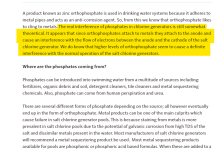I did a search and read a 2011 post about phos in someone's pool BUT Husband was wondering if that could have anything to do with our constant high pH issues. Our FC has been stable all week at 5.5. our SWG is at 70% which I feel is high for this time of year
Did a full test today and results were:
FC 5.5
CH 375 (amazingly and strangely down from the 450 it's been at for two years)
pH was 8.2
TA 70
CYA 50
Salt 3200
WENT to Leslie's last week bc I couldn't believe that with two socks of CYA it was still not registering beyond 20ish (chem new) . it was accurate. and ,shockingly, they were spot on with most of my tests from last week. They said my Phos was 655 and the ideal range is 0-100. They said my salt was 3111.
Did a full test today and results were:
FC 5.5
CH 375 (amazingly and strangely down from the 450 it's been at for two years)
pH was 8.2
TA 70
CYA 50
Salt 3200
WENT to Leslie's last week bc I couldn't believe that with two socks of CYA it was still not registering beyond 20ish (chem new) . it was accurate. and ,shockingly, they were spot on with most of my tests from last week. They said my Phos was 655 and the ideal range is 0-100. They said my salt was 3111.


